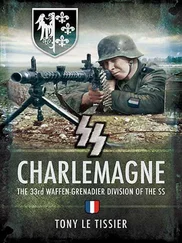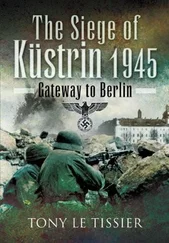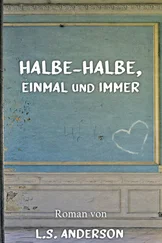By the end of 23 April the Soviet 13th Army had almost reached the Elbe at Wittenberg. Koniev decided to detach its 350th Rifle Division to 4th Guards Tank Army to assist with the screening of Potsdam, and to take over its reserve corps at Luckau as his front reserve and locate it at Jüterbog, where it would be more centrally placed to meet anticipated contingencies. [17] Ibid ., p. 137.
Further south the bulk of 5th Guards Army closed up to the Elbe around Torgau on a wide front that day, thus cutting the remains of the Third Reich in two. Koniev decided to leave only 34th Guards Rifle Corps in that area to await the arrival of the Americans on the opposite bank, and pulled back 32nd Guards Rifle and 4th Guards Tank Corps into the second echelon prior to striking a counterblow at the German forces on his southern flank. These had now penetrated some thirty kilometres towards Spremberg, separating the 52nd and 2nd Polish Armies and creating havoc in their rear areas. [18] Ibid ., pp. 137–41; Komornicki, Polnische Soldaten stürmten Berlin , pp. 128–34.
Although he had just sufficient troops to cope with this emergency in the south, it is clear that Marshal Koniev’s forces were extremely finely stretched at this stage. His active northern front extended in a great loop from Cottbus in the east to Wittenberg in the west, via Berlin, Potsdam, Brandenburg and Beelitz, and he had only a very small reserve in the centre to counter the real threat posed by the German 9th and 12th Armies. [19] Koniev, Year of Victory , p. 124.
It was therefore even more remarkable that he should personally concentrate, with the key members of his front staff, solely on 3rd Guards Tank Army’s penetration of Berlin and the race for the Reichstag.
That evening Lieutenant-General Gerhard Engel’s Ulrich von Hutten Infantry Division set off from the River Mulde with two grenadier regiments, supporting artillery and SPGs, in convoys of vehicles confiscated from construction battalions, factories, rear area units and Nazi Party sources, acting in accordance with orders to establish as big a bridgehead as possible in the Wittenberg area and to hold on as long as possible against the advancing Soviet forces. [20] Gellermann, Die Armee Wenck , p. 78.
The LVI Panzer Corps’ headquarters had moved across the Spree and the southern branch of the Teltow Canal during the night into the suburb of Rudow. Sometime during the day, General Weidling’s chief of staff, Lieutenant-Colonel Theodor von Dufving, telephoned an old friend from his cadet days, Colonel Hans Refior, now on the Berlin Defence Area staff, to ask for news. Refior was surprised when von Dufving told him that the corps was seeking to rejoin 9th Army and had no intention of defending the capital, but enabled von Dufving to re-establish contact with 9th Army Headquarters. General Weidling then spoke to the chief of staff, Colonel Hölz, who gave him orders to secure 9th Army’s northern flank.
From another source Weidling learnt that a general had been sent to Döberitz to arrest him on Hitler’s instructions, so he tried to contact Krebs for an explanation. Eventually he was summoned to report to the Führerbunker at 1800 hours, where he saw Krebs and General Burgdorf. They received him most coolly at first, but once they had heard his account they agreed to put his case to the Führer immediately. [21] Weidling, ‘Der Todeskampf’, p. 42; Gorlitz, The Memoirs of Field Marshal Keitel , p. 221; Tieke, Das Ende zwischen Oder und Elbe , pp. 216–18. Ryan’s interview notes with Refior, von Dufving Archives.
Weidling then told them that he was moving his corps south towards Königs Wusterhausen that night in support of 9th Army in accordance with General Busse’s instructions, but Krebs said that these orders would have to be cancelled as LVI Panzer Corps was needed in Berlin. Weidling saw Hitler shortly afterward and was shocked by the Führer’s appearance and obvious deterioration. When he emerged from this interview, Krebs informed him that, with immediate effect, he was to take over the defence of the city’s south-eastern and southern defence sectors with his corps. LVI Panzer Corps would not be rejoining 9th Army. [22] Weidling, ‘Der Todeskampf’, pp. 42–5; Willemer, p. 19; Tieke, Das Ende zwischen Oder und Elbe , p. 224.
SIX
The Soviets Close In
24 APRIL 1945
On 24 April Colonel-General Vassilii Chuikov’s 8th Guards Army, with 1st Guards Tank Army under its command, and therefore Marshal Zhukov’s strongest striking force, was busy side-stepping to the west to get into position to attack Berlin from the south. However, its plans were unexpectedly modified as the result of a surprise encounter, which must have created a tremendous upheaval at front and army command levels. At about 1030 hours, while some of Chuikov’s troops were traversing Schönefeld Airfield, they unexpectedly came across several tanks from 3rd Guards Tank Army, thus linking up with 1st Ukrainian Front. According to Chuikov, Zhukov did not apparently learn of this encounter until the evening and then acted disbelievingly, insisting that Chuikov send officers to discover what units of 1st Ukrainian Front were involved, where they were located and what their objectives were. [1] Chuikov, The End of the Third Reich , p. 164; Kuby, The Russians and Berlin 1945 , pp. 52–3. Tieke, Das Ende zwischen Oder und Elbe , p. 201, gives the time of encounter as 0900 hours. Zhukov does not even mention it! According to Koniev’s Year of Victory this was 23 April, but it is quite clear from the accounts of both Zhukov and Chuikov that it must have occurred on the 24th.
If, as it appears, this was Zhukov’s first intimation of Marshal Koniev’s participation in the battle for the city itself, we can imagine the consternation this report must have caused. Apart from the blow to Zhukov’s pride, this incident clearly demonstrates the lack of communication between the Soviet leaders and their continuing mutual distrust. Having had his hand revealed, Stalin then laid down the inter-front boundaries, which were to run from Lübben through Teupitz, Mittenwalde and Mariendorf to the Anhalter railway station. Within the city, this meant the distinctive line of the railway leading north from Lichtenrade.
Koniev had obviously been aware of the GHQ order laying down the new inter-front boundaries on the night of the 22nd. When he issued his orders for the attack across the Teltow Canal he deployed 71st Mechanized Brigade on the right flank tasked with establishing contact with 1st Byelorussian Front. The boundary line, when extended beyond Anhalter station, passed well to the east of the Reichstag, giving him the opportunity of reaching it first from the south. Somehow this GHQ order had been withheld from Zhukov, although it had been effective from 0600 hours (Moscow time) on the 23rd, and his balance of forces and reported reactions to the news of this encounter on Schönefeld Airfield clearly demonstrate how unprepared he was for this eventuality. [2] Koniev, Year of Victory , p. 131. The new inter-front boundaries followed the main railway lines into Berlin, being clearly discernible to the troops on the ground, however badly damaged the environment, then crossed the Landwehr Canal to the Anhalter railway station. Any extension of that line left the Reichstag clearly to the west and in Koniev’s path. (Here I disagree with both Ryan, The Last Battle , p. 354, and Erickson, The Road to Berlin , p. 586, for the reasons stated.) North of the canal Zhukov could now only approach the Reichstag from the east, north or west. Chuikov’s group, originally intended to cover the whole southern arc of the city, could now, however, concentrate a disproportionately powerful punch on the eastern flank of that arc in competition with the 3rd Guards Tank Army. From then on one suspects that Zhukov must have pushed Chuikov deliberately to block Koniev’s route to the Reichstag, thus causing the forthcoming changes in the inter-front boundary of 28 April with a fait accompli .
Читать дальше












